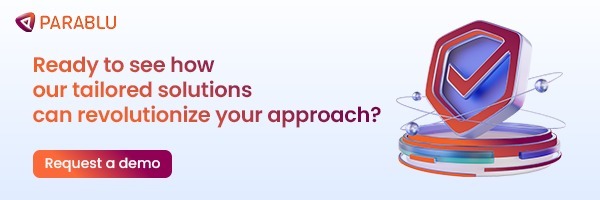Why Your Company Needs Complete Data Backup and Archiving
Learn why data backup and archiving are crucial for your company’s lasting success. Find out how these strategies protect your business, ensuring growth in the long term.
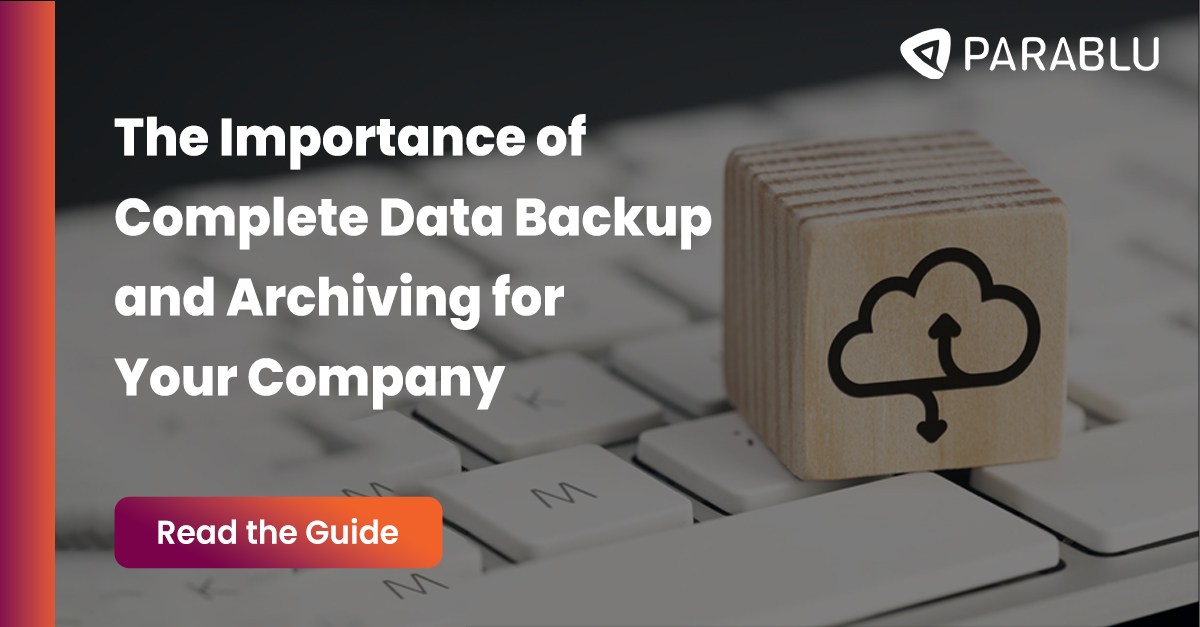
Data backup and data archive are two buzzing words in data security.
Backup and archiving are your allies in the battle for data security. They ensure your data stays secure and accessible, giving you the peace of mind you need.
Understanding the difference between ‘backup’ and ‘archive’ is key to mastering data management. Data backup is like making copies of your important files for safekeeping, ready to swoop in and save the day if disaster strikes. Archiving, on the other hand, is all about long-term storage – think of it as tucking away those old files you don’t need every day but can’t afford to lose. This knowledge empowers you to make the right decisions for your data.
A well-thought-out combination of backup and archive strategies is essential for a robust and comprehensive data management plan.
Discover the significance of data backup and archiving to effectively plan your data security strategy.
Decoding data backup
Data backup refers to creating a duplicate copy of your important data and storing it separately from the original data source. This process ensures you can retrieve the backup data copy to restore the information if the original data is lost, corrupted, or accidentally deleted.
Understanding the key objective of data backup
The primary goal of data backup is to ensure that your data will remain intact and recoverable if the worst happens. Data is vulnerable to various threats like hardware failures, human error, cyber-attacks, or natural disasters. With a backup, you can swiftly recover and resume operations with minimal downtime.
Beyond data recovery, data backup solutions also provide reassurance. Knowing that your critical data is securely stored lets you focus on growth without worrying about potential data disasters.
What are the different types of data backups
Now that we’ve delved into the world of data backup and understood its primary goal, let’s explore the diverse types of data backup to know how they work, and which one might be best for your needs.
Full data backup:
Take your favorite book. A full backup is like making an exact and complete copy of the book. Every chapter, page, and word are duplicated.
A full backup involves copying all your data from a source to a backup location in the data security industry.
For example, if you have 100 gigabytes of data, a full backup will replicate all 100 gigabytes.
Pros:
- Complete restoration: Since everything is backed up, restoring your data is easy and quick.
Cons:
- Time and space: Full backups can take a lot of time and require significant storage space since they copy everything.
Incremental data backup:
An incremental backup is like adding new chapters to the book. Instead of copying the entire book every time, you only copy the new chapters added since the last backup.
An incremental data backup saves only the data that has changed since the last backup, whether that’s a day’s worth of new documents or a week’s worth of edits.
Pros:
- Efficiency: Incremental backups are faster and require less storage space since they only copy new or modified data.
- Reduced bandwidth usage: If backups are done over a network, incremental backups consume less bandwidth than full backups.
Cons:
- Dependency: To restore your data, you need the last full backup along with all the incremental backups since then. This dependency chain can complicate the restoration process.
But Parablu has a solution to this challenge. First, it does a complete backup of everything; then, it only backs up the things that have changed since the last backup. Files more significant than a certain threshold are further processed using our Partial File Incremental Backup algorithm, which only transmits the changed portions of such files (like PSTs).
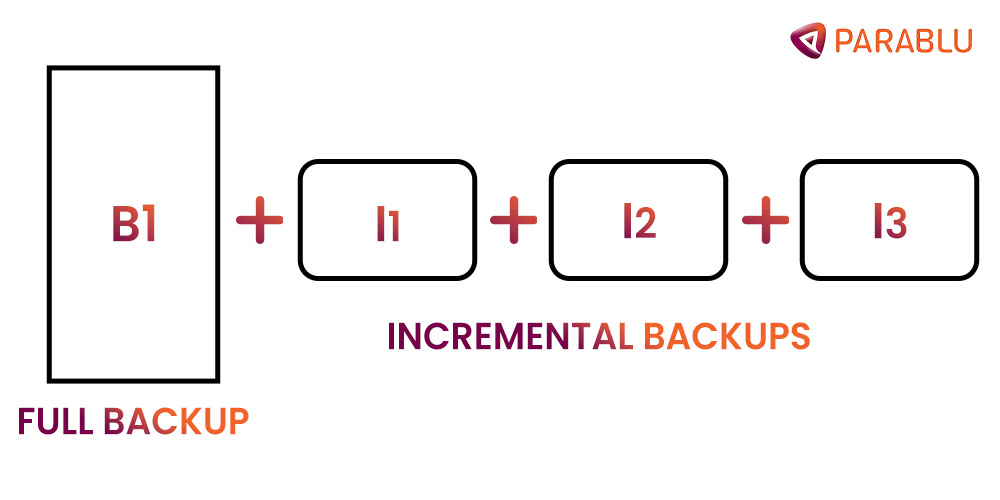
Differential backup:
Imagine your data is a book on a shelf. Differential backup captures all the changes made since the first backup, making it a complete snapshot of what’s different from the start.
Unlike incremental backups, which only capture changes since the last backup, a differential backup captures all changes since the previous full backup.
Pros:
- Simplicity: Unlike incremental backups, you only need the last full backup and the latest differential backup to restore your data, making the restoration process simpler.
- Faster restoration: Restoring data from a differential backup is faster than restoring from incremental backups since you only need to apply one differential backup.
Cons:
- Increased storage usage: Differential backups consume more storage space compared to incremental backups because they accumulate all changes since the last full backup, not just the changes since the last backup.
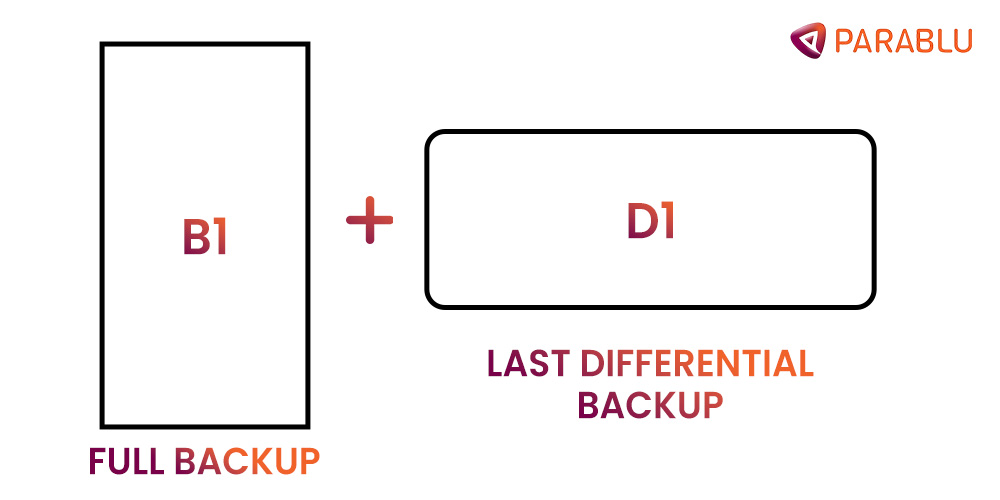
| Full Data Backup | Incremental Data Backup | Differential Data Backup |
Definition | Captures entire data at a point. | Backs up changed data since last backup. | Backs up changes since the last full backup. |
Size | Contains all selected data, resulting in a larger backup size. | Only includes changes made since the last backup, resulting in a smaller size. | Contains all changes made since the last full backup, resulting in a larger size compared to incremental. |
Frequency | Typically performed less frequently (e.g., weekly) | More frequently captures changes since last full backup. | Performed regularly, capturing changes since the last full backup (e.g., daily).
|
Dependency | Independent of other backups. | Depends on the previous incremental backup. | Depends on the previous full backup. |
Restoration time | Longer restoration time. | Shorter but sequential for each incremental. | Faster than full backup, slower than incremental backup. |
Storage efficiency | Lower efficiency due to larger size. | Higher efficiency as it captures only changes. | Moderate efficiency, capturing all changes since the last full backup. |
Complexity | Higher complexity due to the need to back up the entire dataset | Lower complexity since it focuses on changes. | Moderate complexity, as it involves capturing changes since the last full backup. |
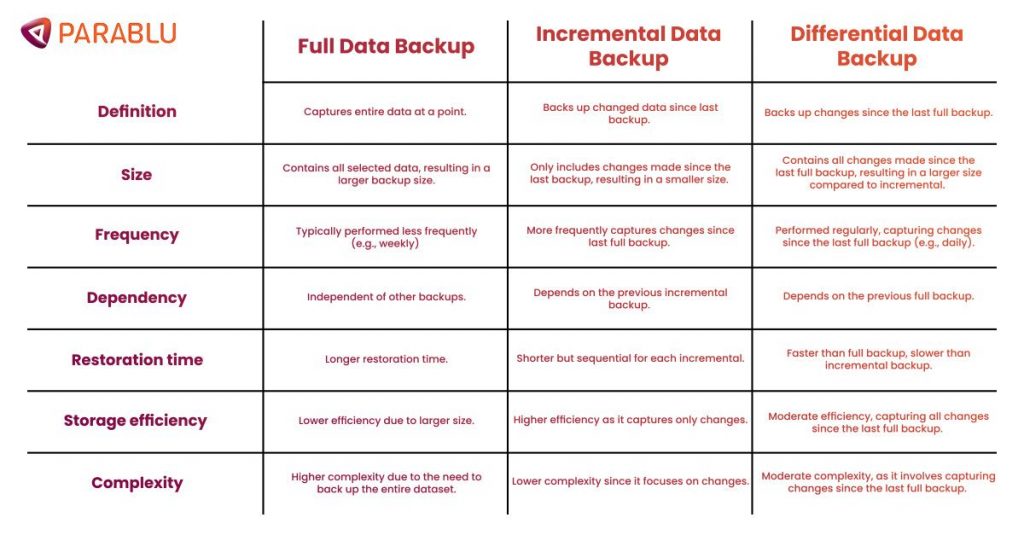
Ultimately, the choice between full, incremental, or differential backups depends on your needs and constraints. Remember, whatever data backup strategy you choose for either endpoint or M365, ensure it aligns with your data protection goals, and you’ll be well-prepared for the unexpected twists and turns.
BluVault: Top-rated data backup solution on G2
For accurate data backup and recovery, you need a reliable solution.
So, here is the name well trusted for data backup and recovery. Yes, BluVault; trusted by companies across the globe.
BluVault redefines data backup with intuitive policy controls, cost-saving benefits, robust encryption, and compliance adherence. Its user-friendly interface simplifies policy management, reducing administrative burdens. By enhancing security measures, BluVault ensures that you don’t end up paying more. Seamlessly integrating with your existing OneDrive and Google Drive accounts, BluVault ensures efficient backup data storage. Thus, you can save exceptionally up to 70% on storage costs over a three-year span with BluVault. Also, it lowers your insurance premiums by up to 41%, delivering tangible financial benefits. These are just two features of our solution. If you want to know more about us, read our datasheet here.
Let’s start with the second buzzword: data archive
Demystifying data archive
Data archiving takes a different approach; it’s more than just storing data here and now. It’s strategic, long-term data preservation that might not be actively used but holds immense value for compliance, historical reference, or future analysis.
Imagine your data as a vast library. Data backup is like regularly checking out books to ensure you have the latest editions. Archiving, on the other hand, is like carefully cataloging and storing those books in a climate-controlled, secure archive for future generations.
Read More: Demystifying Data Backups and Their Types
Types of data archives:
Now that we have a foundational understanding of what data archiving is let’s explore the different types of data archives:
Active archives:
Active archives are repositories for regularly accessed data and remain part of ongoing business operations. This could include frequently referenced documents, recent project files, or any information actively used, ensuring quick and efficient access to your most important data, giving you the confidence that your crucial data is always at your fingertips.
Inactive archives:
In contrast, inactive archives house data that is rarely accessed in an organization’s day-to-day operations but must be retained for compliance, legal, or historical reasons. These archives are designed for the long-term storage of information that is no longer actively used but still holds value, emphasizing the crucial role of data retention in maintaining compliance and preserving historical records.
Hybrid archives:
For organizations seeking a balanced approach, hybrid archives offer a combination of both active and inactive archives. This strategy allows companies to manage the accessibility of their data effectively.
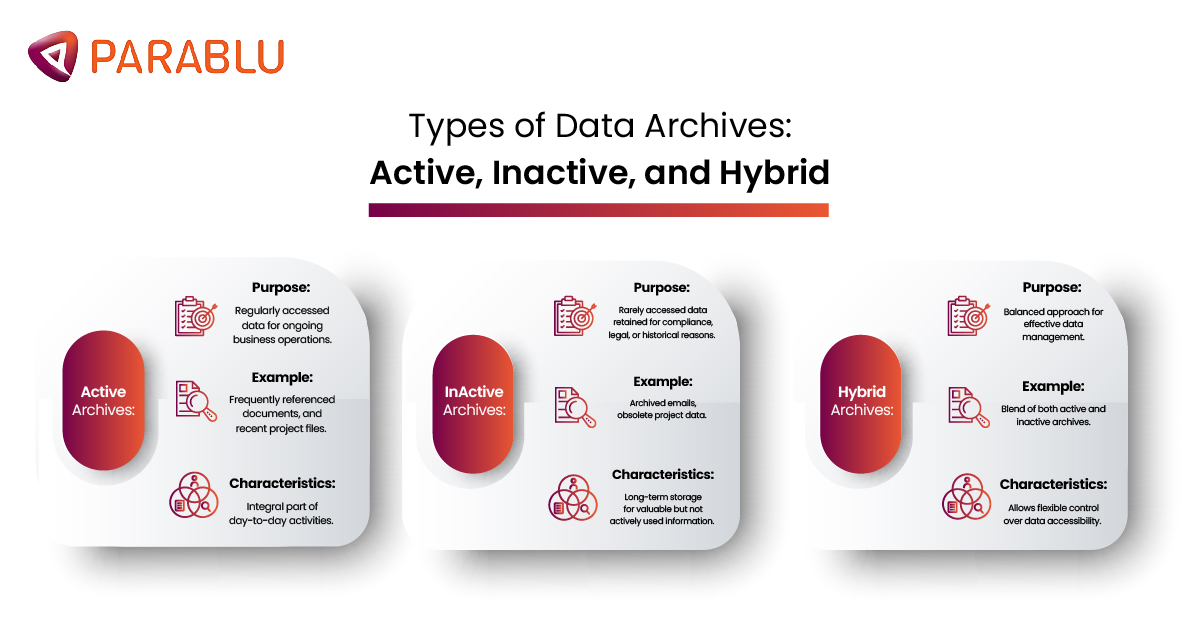
BluVault's approach to data archiving
If you are looking for a reliable way to handle your data archiving needs, why don’t you give BluVault a chance?
BluVault has features like advanced archiving that will leave you amazed. With BluVault, you’ll never have to worry about losing an email again. Seriously, every single one gets securely stored away for safekeeping. Also, it’s not just about dumping stuff into a digital storage closet. BluVault uses advanced features to organize everything smartly and securely, so you can easily find what you need without digging through endless folders.
And what about searchability?
Oh, it’s quick and super easy, like magic. If you want to find an email from last year, all you need to do is enter a keyword, and voila! BluVault digs it up in seconds.
Then, finally, there is data security.
It’s top-notch. BluVault locks down your data with encryption and follows all the rules, so you can rest easy knowing everything’s compliant and safe. If you want a hassle-free way to manage your organization’s data archives, BluVault is worth checking out.
Understanding the difference between data backup and archiving
Keeping a note of the distinctions between data backup and data archiving is crucial for maintaining robust data security within a company. While both practices involve storing data for future use, they serve distinct purposes and possess unique characteristics. This comparative analysis aims to delve into the intricacies of data backup and archive, shedding light on their functionalities, significance, and strategic roles in data security.
- Data retention period:
Typically, backups are done regularly and usually retain a relatively short-term data history.
On the other hand, data archiving involves storing ‘no longer actively used data’ that needs to be retained for future reference or compliance reasons. Archives are designed for long-term retention, often spanning years or even decades.
- Accessibility and retrieval:
Accessibility and retrieval play a significant role in distinguishing between a data backup and a data archive. Usually, you do backups with the intent of quick and easy access in case of data loss or system failure. They prioritize rapid recovery to minimize downtime and ensure business continuity. This means that backups are often readily available and easily retrievable when needed.
In contrast, data archives are not typically designed for frequent access. Archived data may be stored in offline or nearline storage systems, requiring additional steps for retrieval compared to backups.
- Storage management:
Storage for backups relies on disk or cloud solutions for swift data protection, optimized for frequent operations. Conversely, data archives may use tape, optical discs, or specialized disks based on cost, reliability, and compliance. Efficient storage management is vital for maintaining data integrity and accessibility in backup and archive processes.
- Regulatory compliance:
Regulatory compliance is crucial in data management in all industries, including healthcare, manufacturing, banking, finance, etc. Backups prioritize meeting recovery goals and service agreements, while archives adhere to specific retention, encryption, and audit trail regulations. Compliance is imperative to avoid penalties and build stakeholder trust in backup and archive practices.
- Cost considerations:
Data backups entail recurring storage, licenses, and maintenance expenses in cost analysis, scaling with data volume. Data archives involve upfront infrastructure costs, with lower per-terabyte storage expenses but accumulating over time due to data migration, refresh cycles, and compliance-related requirements. Balancing these costs is vital. The best way to ensure the cost of the backup and archiving is to manage the things coming ahead.
When securing your enterprise data, the ball is in your court to decide whether data backup or archiving is the better fit. Take a moment to weigh your needs, budget, and urgency. Consider whether a data backup or archiving approach aligns better with your enterprise’s unique demands.
Parablu's cost-effective data backup solutions for enterprises
Whether it is protecting customer information, financial records, or intellectual property, you need iron-clad security from any potential threats. That’s where Parablu enters with its excellent solution, BluVault for data backup.
A robust data backup strategy is indispensable for business continuity. Data backup creates duplicate copies that are stored securely, allowing quick recovery from disasters or cyber threats. Unlike archiving, which focuses on long-term retention, backup ensures immediate access to critical information, reducing downtime and financial risks.
We are a leading data security solution provider, pivotal in enhancing enterprises’ data backup strategies. By leveraging advanced technologies, we offer secure and automated backup solutions that cater to the evolving needs of modern businesses.
Here are some key benefits of considering BluVault for data backup:
- Automated data backup processes: BluVault streamlines the backup process, automating routine tasks and reducing the risk of human error. This ensures that critical data is consistently and efficiently backed up without manual intervention.
- Security and compliance: Parablu prioritizes data security, employing encryption techniques to secure sensitive information during transit and storage.
- Scalability: Enterprises evolve, and so does their data volume. Parablu’s scalable solutions accommodate businesses’ growing data needs, providing a future-proof backup strategy that aligns with organizational growth.
- Efficient recovery: In the event of data loss or system failures, BluVault facilitates swift and efficient recovery, minimizing downtime and ensuring continuity in business operations.
- Cost-effective solutions: Parablu’s offerings are designed to provide cost-effective cloud data backup solutions without unnecessary expenses. We help you save up to 70% on your TCO and 41% on cyber insurance. To learn more about BluVault, visit our page here.
Data backup, significantly enhanced by solutions like Parablu, is a more suitable option for enterprises. We offer a bundle of solutions offering a comprehensive and agile approach to data protection. Cohesity accepts all solutions that align with the dynamic nature of today’s business environment.
Conclusion:
The synergy between data backup and archiving is essential to ensuring a company’s long-term success. While data backup provides immediate recovery solutions for operational continuity and disaster resilience, data archiving ensures compliant storage and retrieval of historical data for analytics and business insights. BluVault is Parablu’s solution known for its reliable data backup and recovery. Request a demo if you want to know how Bluvault can help you secure your data.
Together, they form a comprehensive data management strategy that protects against data loss, facilitates efficient data access, and supports informed decision-making. By investing in backup and archiving solutions, companies can mitigate risks and optimize resource utilization for sustained growth and competitiveness in the digital era.
